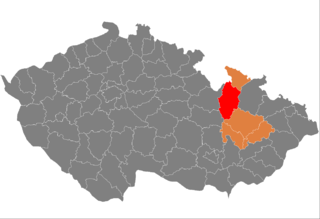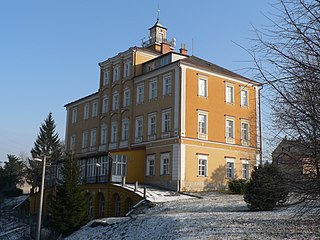
Olomouc Region is an administrative unit of the Czech Republic, located in the north-western and central part of its historical region of Moravia (Morava) and in a small part of the historical region of Czech Silesia. It is named for its capital Olomouc.

Loučná nad Desnou is a municipality and village in Šumperk District in the Olomouc Region of the Czech Republic. It has about 1,500 inhabitants.

Šumperk is a town in the Olomouc Region of the Czech Republic. It has about 25,000 inhabitants. It is an industrial town, but it also contains valuable historical and architectural monuments. The historic town centre is well preserved and is protected by law as an urban monument zone.

Bludov is a spa municipality and village in Šumperk District in the Olomouc Region of the Czech Republic. It has about 3,000 inhabitants.

Zábřeh is a town in Šumperk District in the Olomouc Region of the Czech Republic. It has about 13,000 inhabitants.

Rapotín is a municipality and village in Šumperk District in the Olomouc Region of the Czech Republic. It has about 3,300 inhabitants.

Libina is a municipality and village in Šumperk District in the Olomouc Region of the Czech Republic. It has about 3,300 inhabitants.

Šumperk District is a district in the Olomouc Region of the Czech Republic. Its capital is the town of Šumperk.

Sobotín is a municipality and village in Šumperk District in the Olomouc Region of the Czech Republic. It has about 1,100 inhabitants.

Moravičany is a municipality and village in Šumperk District in the Olomouc Region of the Czech Republic. It has about 1,300 inhabitants.

Dolní Studénky is a municipality and village in Šumperk District in the Olomouc Region of the Czech Republic. It has about 1,400 inhabitants.

Jindřichov is a municipality and village in Šumperk District in the Olomouc Region of the Czech Republic. It has about 1,100 inhabitants.

Postřelmov is a municipality and village in Šumperk District in the Olomouc Region of the Czech Republic. It has about 3,000 inhabitants.

Ruda nad Moravou is a municipality and village in Šumperk District in the Olomouc Region of the Czech Republic. It has about 2,600 inhabitants.

Vikýřovice is a municipality and village in Šumperk District in the Olomouc Region of the Czech Republic. It has about 2,300 inhabitants.

Petrov nad Desnou is a municipality and village in Šumperk District in the Olomouc Region of the Czech Republic. It has about 1,200 inhabitants.

The Desná is a river in the Czech Republic, a left tributary of the Morava River. It flows through the Olomouc Region. It is 43.4 km (27.0 mi) long.

Bludov Chateau is a manor house in Bludov in the Olomouc Region of the Czech Republic. It is a Baroque building with late Renaissance elements.

The Paper mill at Velké Losiny is a historic mill in Velké Losiny in the Olomouc Region of the Czech Republic. It was founded in the late 16th century and is manufacturing handmade paper to this day. The four-hundred-year continuity of traditional handmade paper production is unparalleled in Central Europe and in 2001 the paper mill was declared a Czech national cultural monument.

























